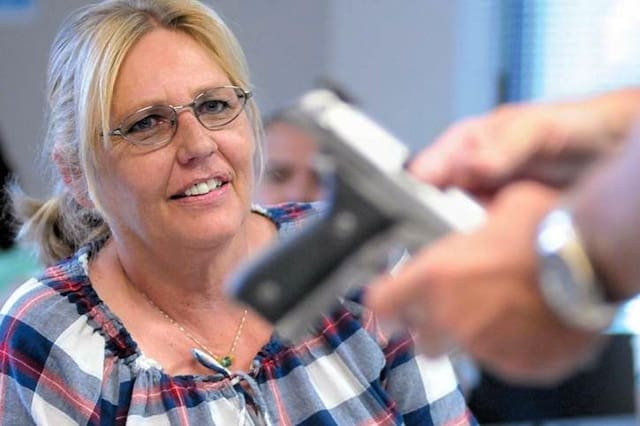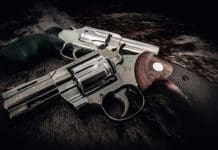Millions of kids daily suffer the life’s-so-unfair injustice of a parental my-house-my-rules verdict. And it’s usually fair – when Johnny and Susie can hold down a job, pay rent, utilities, insurance, feed themselves, etc. then they can choose their own rules. Of course, it’s a lot more difficult to stomach mom and dad’s rules when they use the do-as-I-say-not-as-I-do approach. We all know that cussing, sleeps ’til noon, lush mommy’s going to have a little trouble gaining positive traction with the kids on a variety of issues . . .
Now, my idea of successful parenting – hey, I managed to keep ’em alive another day – differs a wee bit from my wife’s. I’m no Dr. Phil. But when it comes to teaching others about firearms, I do know that there’s no room for do-as-I-say-not-as-I-do. The rules are the rules are the rules. Finito!
Which is why, while scanning my daily news intake, I stopped short on the photo above, which is captioned:
XXX … listens to instructor YYY talk about the proper way to ensure a gun is unloaded during a class … **
Okay, maybe I’m wrong, but I tried and tried and just can’t seem to replicate the wrist angles shown with a training gun without muzzling myself or nearly so, and I’m flexible. Without hyperextending one’s elbow the left wrist just has to bend back more to get the muzzle to point across well in front of one’s body instead of at it.
Correspondence with the unnamed instructor yielded this response:
The angle in the picture is somewhat deceiving, I was bladed (sideways) when I showed XXX that, During that Class, and (always) I never point a firearm at anyone, ( especially myself!!!)
I suspected this would be the response. And I’m not going to send the photo off to a biomechanics expert to deconstruct and refute the claim. As I said, maybe I’m wrong. But even if the instructor wasn’t violating Cooper’s Rule #2 (Never let the muzzle cover anything you are not willing to destroy), is holding the gun backward by its barrel really a safe thing to be doing, let alone demonstrate to students? You are just a handful degrees away from an unintentional Rule #2 violation. IMO, it’s a very questionable practice.
Sure, I understand that when you’re in front of a group of people trying to demonstrate a technique, you want to face them so they can hear you. You don’t want to pointing the gun at them, duh. But that’s an inconvenience, not an excuse for pointing the gun at yourself or holding a gun in a way that makes it very likely you’ll unintentionally point it at yourself.
If you’re teaching others about guns, whether it’s an informal one-on-one session or a formal class room environment, you need to figure out how to manage your real estate so that you, the instructor, ALWAYS follow the rules, just as you’d expect of the students. And instead of doing things that may technically be safe but which are prone to accidents, figure out a better way.
When you say, don’t do X and later proceed to do X, it has a profound impact on students, whether or not they connect the dots at the time. They see you doing something wrong but conclude there must be some acceptable reason for it, even if they can’t think of the reason. After all, you’re supposed to know what you’re doing.
The results? While a few will wisely stick to the rules regardless, some will simply be too casual with the rules and be blind to the violations. Worse, others will start rationalizing obviously bad practices by saying, “but I saw the instructor do it.”
At the very least, you won’t have a photo of you doing something questionable turn up online to your embarrassment. More importantly, you can rest well at night knowing you’ve not led your students astray.





I don’t know what the instructor did before this photo was taken. In this picture, the action is open and it looks like the instructor has inserted a finger into the chamber to see if there’s a round hiding in there. We don’t know if he first removed the magazine. If he did, then unless the gun in the picture works differently than mine do, his pistol is safe.
nitpicking
OK, now I feel the need to expound on my original post.
“…is holding the gun backward by its barrel really a safe thing to be doing…”
In my opinion, yes. As long as the muzzle is not covering anyone I see no problem.
If we are going to get this absurd critiquing someone handling a firearm from a photo then we might as well hang it up and just put our firearms away. Obviously they are simply too dangerous to handle safely, even if the rules are followed.
Yeah, I’m cool with that picture.
The action is open and (it looks like) the magazine is out.
As in most things, I’m an absolutist. Never point a gun at something you don’t want to destroy means never. I’m not saying my gun handling is perfect. But it should be. A teacher? Yes. Always.
What happens if you remove the barrel? When does it cease to become a gun? Can you clean a rifle without muzzling yourself? I can’t. When did a gun get the magic power to shoot with the mag removed, the action open, and a finger in the chamber (which mean there can’t be any cartridge in there). Absolutism in most things is absolutely nuts and Van’s post is accurate. I think you’ve misinterpreted the Four Rules and turned them into the Four Magic Incantations.
This brings up a personal debate I have been having between a group of shooters and myself. At what point can you disregard Jeff Cooper’s 4 rules. There are some times when you have to look down the barrel of your own rifle to check the rifling, and you can’t do that without violating Cooper’s Second Rule. When you have verified that a gun is empty and unloaded rule 1 can present problems. If I know the gun is safe and unloaded, and the people I am with know the firearm is safe and unloaded, is the gun still loaded? Is there a ever a time when I am handling my firearm that I can look at it and say, it’s unloaded and mussel myself to clean the pistol and inspect it?
You can ignore the four rules when the gun is not a gun. The way I was taught was that when the action is open, the mag removed and the piece inspected and shown clear, it’s no longer a gun, it’s a paperweight. But everybody who touches the gun must perform the inspection.
First off, I could easily show you how he got the gun like that without ever lasering anyone, including himself, without over-dramatic contortions of my hands.
I want to expand a little on Ralph’s post. When I clean my bolt guns, I remove the bolt. The rifle in incapable of firing. It is SAFE. I shoot corrosive ammo from it, so I often inspect the bore with a bore light. I remove the bolt from the gun, insert the light into the chamber and peer down the barrel… am I afraid of shooting myself? No.
If it was necessary to follow the rules at all times, no exceptions, then there could technically be no gunsmiths since the vast majority of work performed would require the gunsmith to put SOMETHING in front of the barrel during the course of work. With that in mind, there could be no guns manufactured, since during the course of assembly, one must put something in front of the barrel that cannot be destroyed.
I feel that chances are, in whatever class the picture is from, what was being taught was probably more beneficial than an unwavering view of the rules. If he WAS “lasering” himself, he did so after thoroughly clearing the weapon and mitigating the risk to an acceptable level for himself. He wasn’t being reckless (magazine out, action open, finger in the chamber… how exactly could that possible fire?). He wasn’t pointing it at someone else. The firearm was not out of his control. He was putting no one in “danger” other than himself.
To look at it another way… we’re all taught to never touch live powerlines. They’re incredibly dangerous. One wrong move and you’re dead. Etc. Etc. However, people regularly work on LIVE powerlines. They do so after mitigating the risk to an acceptable level. However, if we had an unwavering view of the rules, no one could ever touch powerlines because they’re inherently dangerous.
Just like not touching powerlines, following the rules for safe firearm handling is a good idea in general practice. However, once one goes above and beyond (think of it like lock-out / tag-out in an industrial setting)and takes additional steps for safety, additional risks can be taken.
Three words: BIG BOY RULES
I had an instructor use that line on me once. I went to the office and got my money back, and quickly left the property before someone got hurt. “BIG BOY RULES” have no place in a regular training class.
IMNSHO they should only be used by and among professionals who are training in group tactics. By professionals, I mean people who make their living with guns. If the group includes that podiatrist who decided to blow 3 grand on a “BIG BOYS RULES” class, I wouldn’t get within range of that place.
I’ll qualify the article by saying there’s a time and a place. I think those teaching introductory shooting should choose to use obviously safe techniques that the students can easily mimic and avoid demonstrating actions that can be done safely, but which are difficult to do safely properly.
I do lean more toward the absolutist perspective. But, yes, there are cases where Cooper’s rules can’t be applied black and white. For one, I view guns that are not being handled differently than ones being handled. I’ll walk in front of a gun that’s properly cased or holstered, lying in a display case, or sitting action-open on an outdoor firing line pointed downrange, not being touched while people clear and set targets. It sounds like petty, semantics argument, but these guns are pointing at something we don’t want destroyed, but are not being pointed. They’re safe because no one is messing with them and are effectively incapable of firing. Once someone starts messing with them, that can change in an instant.
As for cleaning and gunsmithing, the ideal (IMO) is to render the firearm incapable of firing. I’ll remove the bolt on a rifle as Ian suggests when cleaning it. I’ll field strip a handgun if straight forward, removing barrel from the slide before I consider it safe. And in the cases of the few guns I own that can’t be disabled, then yes, I will clean a gun from the muzzle end having only made certain the gun is unloaded and no ammunition is nearby.
I generally err on the side of more caution when it can be done with reasonable effort. Call me silly, but I unplug the garbage disposal before rooting around for indestructible chunks that won’t go down even though I have a direct sight line to the wall switch and can easily pull my hand out if someone happens to reach for it. I rarely do house wiring without flipping breakers even though I’m perfectly capable of managing to not complete a circuit via my body if I pay good enough attention. These safeguards are so easy to utilize, why not use them. And if I’m teaching my son to do either of these, I’ll be damned if I’m going to show him it’s okay not to use them and I’ll make sure he uses them too.
Whenever I hear of someone being accidentally shot, the excuse is that they thought the gun was empty. The have safety rules for a reason and they should always be followed. When people start to get lax with the rules they tend to get sloppy and sometimes really bad sh@t happens as a result of their actions. I hate when people laser me with empty (or real ones) guns because I was always taught not to laser others, and I don’t want them doing it to me.
As has been stated here before – you have to violate two rules before you can have an ND.
I don’t think you can have an abolitionist position on this and actually use a gun. If you CC you inevitably “laser” yourself or someone else. For example I carry at the 5 o’clock position which means that my gun is pointed at my ass to varying degrees and as I walk my foot and leg are “lasered” by my sidearm the whole time I’m carrying.
Even if you carry OWB on your hip your going to “laser” your leg at some point unless your very careful about your movements.
Shoulder holsters are decried for your inability to use them without “lasering” yourself or others during a holster/re-holster. Supposedly there are ways to do it “safely” but I’ve never been able to see anyone demonstrate this in real life. But I don’t think it matters because “lasering” isn’t an issue if you don’t break at least two of the rules. The main one not to break (at least in the case of the examples I gave) would be to keep your finger (and foreign objects) away from the trigger.
It does seem like an odd way to demonstrate clearing a gun… even for “demonstration purposes”.
Comments are closed.